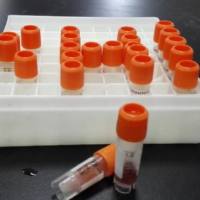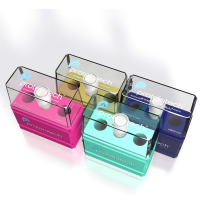Multicolour 3D-FISH in vertebrate cells
互联网
Introduction
Multicolour 3D-FISH in combination with confocal microscopy, 3D image reconstruction and quantitative image analysis is an efficient tool for the analysis of the 3D genome structure and of the spatial relationship of defined nuclear targets comprising entire chromosome territories down to the level of single gene loci. Until a few years ago the drawback of confocal microscopy was its limitation to three or at maximum to four different fluorochromes that could be visualized simultaneously. Recent developments of a "new generation" of confocal microscopes allow the simultaneous excitation and distinct visualization of five different fluorochromes (the number can be increased if colour unmixing software is used) within one experiment, opening the way for a simultaneous delineation of numerous differently labeled intranuclear targets.
Here we provide protocols for the preparation of complex DNA-probe sets suitable for 3D-FISH with up to six different fluorochromes, protocols for 3D-FISH on cultured mammalian cells (growing in suspension or adherently growing), and protocols for an efficient 3D-FISH on tissue sections, that have all been used successfully by our group. We restrict to protocols describing the labeling of a given DNA probe (such as chromosome specific probes, BACs or plasmids etc.) with a single hapten or fluorochrome. We should mention here that the term M-FISH (which is originally the abbreviation for multiplex (!) FISH and not for multicolour FISH) is often related to the combinatorial labeling of a probe with different, usually two or three fluorochromes/haptens in order to increase the number of distinguishable targets. While this approach has been widely used as a tool for the complex analysis of metaphase chromosomes and interphase cytogenetics, its successful application for 3D-FISH on 3D preserved nuclei in combination with confocal microscopy has been shown only in a few studies (see e.g. Bolzer et al . (2005)). This is mainly due to the fact that analysis of confocal image stacks containing combinatorial labeled probes is highly demanding and requires specialized skills. For the special aspects with regard to the generation of DNA probes by combinatorial labeling we kindly ask you to refer to the papers of Bolzer et al ., (2005) and Fauth et al ., (2001).
Finally we want to emphasize that multicolour FISH on 3D preserved nuclei is a somewhat delicate method where minor deviations or experimental mistakes can easily change the quality of an experiment. For readers that are interested to concern this technique in more detail we refer to our previous and recent publications (Solovei et al . 2002a; Solovei et al . 2002b; Walter et al . 2006)
Back to top
Procedure
Probe preparation and labeling procedures
High quality of probe labeling is crucial for efficient 3D-FISH experiments. Most DNA-probes are efficiently labeled by the PCR amplification techniques described below, which saves time and material. Even complex probe pools, containing e.g. large sets of BAC pools can be labeled by this method. Direct labeling of probes by incorporating fluorochrome-conjugated nucleotides (such as FITC-dUTP, TAMRA-dUTP, TexasRed-dUTP and others) has been quite successful following our protocols and can be considered equally efficient in comparison to hapten-labeled probes (Biotin, Digoxigenin and DNP).
Probe preparation
Although a large number of labeled DNA probes are commercially available, we strongly encourage to generate own probes. This saves money and insures higher flexibility in designing experiments. An official source to obtain chromosome specific DNA probes is provided by M. Rocchi, University of Bari (http://www.biologia.uniba.it/rmc/).
In the following section we present protocols for the generation of DNA probes frequently used in 3D-FISH experiments
Chromosome painting probes
Chromosome painting probes are usually generated from flow sorted chromosomes. The genomic DNA is initially amplified by DOP PCR using the universal primer 6MW (Telenius et al ., 1992). The amount of this primary amplification product can be increased by one or a few further rounds of DOP amplification (see note 1). The amplified DNA is used for the subsequent labeling DOP-PCR (see figure 1).
Standard reaction for (re-)amplification for a single DOP amplification reaction
| 48.5µ | MM |
| 30-200ng | DOP amplified DNA (normally corresponds to 1µl) |
| 0.5µl | Taq-Polymerase |
Mastermix for the amplification of DNA by DOP-PCR using the 6MW-primer (see comment 1)
| MM for 20 reactions | concentration in reaction | |
| 200µl | PCR Buffer D 5x (Invitrogen Cat K1220-02D) | 1X |
| 100µl |
6 MW-primer (20µM) (sequence CCGACTCGAGNNNNNNATGTGG) |
2µM |
| 100µl | Polyoxyethylene ether W1 (1%) (SIGMA Cat P7516) | 0.1% |
| 80µl | dNTP-mix (2.5mM each) | 200µM |
| 490µl | H2 O |
For a single DOP-PCR reaction we use 48.5µl MM + 1µl of the DOP amplified DNA + 0.5µl Taq-Polymerase (5U/µl).
Features of DOP amplification cycles (see note 2)
| Primary | Secondary | ||
| Initial denaturation | 96°C 3'00'' | 96°C 3'00'' | |
| Low stringency (x8) | Denaturation | 94°C 1'00'' | |
| Annealing | 30°C 1'30'' | ||
| Extension | time ramp 14°C/min 72°C 2'00'' | ||
| High stringency (x35) | Denaturation | 94°C 1'00'' | 94°C 1'00'' |
| Annealing | 56°C 1'00'' | 56°C 1'00'' | |
| Extension | 72°C 2'00'' | 72°C 2'00'' | |
| Final extension | 72°C 5'00'' | 72°C 5'00'' | |
| Approximate time | 4hr 15' | 3hr |
Standard reaction label-PCR for a single DOP labeling reaction
| 48.5µl | MM |
| 30-200ng | DOP amplified DNA (normally corresponds to 1µl) |
| 0.5µl | Taq-Polymerase |
Labeling DOP-PCR e.g.Bio-dUTP (see note 3 and note 4 and comment 1)
| MM for 20 reactions | Final concentration | |
| 100µl | GeneAmp PCR Buffer 10x (Applied Biosystems, N808-0130) | 1x (50mM KCl, 10mM Tris, pH8.3) |
| 80µl | MgCl2 (25mM) | 2mM |
| 100µl | 6 MW-primer (20µM) | 2µM |
| 50µl | ACG-mix (each 2mM) | 100µM |
| 80µl | dTTP (1mM) | 80µM |
| 20µl | Bio-dUTP (1mM) | 20µM |
| 530µl | H2 O (bi-distilled) |
We use 48.5µl MM + 1µl of the DOP amplified DNA + 0.5µl Taq-Polymerase (5U/µl) for a single DOP labeling reaction.
Features of DOP-labeling cycles
| x20 | Initial denaturation | 94°C 3'00'' |
| Denaturation | 94°C 1'00'' | |
| Annealing | 56°C 1'00'' | |
| Extension | 72°C 0'30'' | |
| Final extension | 72°C 5'00'' | |
| Approximate time | 1hr15' |
Locus specific probes from BAC clones
We usually order BAC probes from the C.H.O.R.I. BACPAC Resources Center.
Genomic DNA from BAC clones can be obtained by any conventional DNA purification method. Prior to amplification of the BAC-DNA RNAse-treatment and concentration measurements (by gel control or spectrophotometer) should be performed (50-100ng/ µl). For a primary amplification and subsequent labeling of BAC-DNA for 3D-FISH we use a modified DOP-PCR employing two different primers in separate amplification reactions described as DOP2 and DOP3 by Fiegler et al . (2003) (see note 5).
We perform the amplification and labeling reactions in separate PCR-setups for each DOP2 and DOP3 primer.
Standard reaction for a single DOP 2 or DOP3 amplification reaction
| 33µl | MM |
| 2µl | DNA (50-200ng) |
| 15µl | H2 O(Bi-distilled) |
| 0.5µl | Taq-Polymerase |
DOP2 and DOP3-PCR (see note 6)
| MM for 20 reactions | Final concentration in final reaction set up | |
| 200µl | PCR Buffer D 5x (Invitrogen Cat K1220-02D) | 1x |
| 100µl | DOPundefined or DOPundefined~Fprimer_~A20µM) | 2µM |
| 100µl | Polyoxyethylene ether W1 (1%) (SIGMA Cat P7516) | 0.1% |
| 80µl | dNTP-mix (each 2.5mM) | 200µM |
| 180µl | H2 O (bi-distilled) |
~undefined Primer sequence DOP 2: (CCGACTCGAGNNNNNNTAGGAG)
~undefinedPrimer_sequence_DOP_3~I_~ACCGACTCGAGNNNNNNTTCTAG~B~K~Hp~M~2~1~0~Kp~M~2~1~0~0Standard_reaction_per_single_reaction_for_each_primer_set~I~Kbr_~H~M~2~1~0~033µl MM + 2µl DNA (approx. 50-100ng/µl) + 15µl H2 O (bi-dist.) + 0.5µl Taq-Polymerase (5U/µl)
Features of DOP2/ DOP3 amplification cycles (see figure 2)
| Initial denaturation | 96°C 3'00'' | |
| Denaturation | 94°C 1'30'' | |
|
Low stringency (only for primary amplification) (10 cycles) |
Annealing | 30°C 2'30'' |
| Time ramp 6°C/min extension | 72°C 3'00'' | |
|
High stringency (30 cycles) |
Denaturation | 94°C 1'00'' |
| Annealing | 62°C 1'30'' | |
| Extension | 72°C 2'00'' | |
| Final extension | 94°C 1'00'' | |
| 62°C 1'30'' | ||
| 72°C 8'00'' | ||
| Approximate time | 4hr 30' |
The amplification product is used for the labeling reaction employing the same two primer sets.
Standard reaction for a single DOP 2 or DOP3 label PCR reaction
| 47.5µl | MM |
| 1-3µl | DNA of DOP2 or DOP3 amplification product, (see below) |
| 0.5µl | Taq-Polymerase. |
DOP2/DOP3 PCR probe labeling with hapten-dUTP (e.g. Biotin-dUTP)
| MM for 20 reactions | Final concentration in reaction | |
| 100µl | GeneAmp PCR Buffer 10x (Applied Biosystems, N808-0130) | 1x (50mM KCl, 10mM Tris, pH= 8.3) |
| 80µl | MgCl2 (25mM) | 2mM |
| 100µl | DOP2 or DOP3-primer (20µM) | 2µM |
| 50µl | ACG-mix (each 2mM) | 100µM |
| 80µl | dTTP (1mM) | 80µM |
| 20µl | Biotin-dUTP (1mM) | 20µM |
| 530µl | H2 O |
For each primer set use per single reaction: 47.5µl MM + 2µl DNA (primary DOP2/DOP3 amplification, 50-100ng/µl) + 0.5µl Taq-Polymerase (5U/µl)
DOP2/DOP3 labeling PCR with directly labeled dUTP (e.g.TAMRA-dUTP)
For directly labeled nucleotides we prefer to set up first the mastermix and the fluorescent labeled dUTP is added before starting up the reaction.
| MM for 20 reactions | Final concentration in reaction | |
| 100 µl | GeneAmp PCR Buffer 10x (Applied Biosystems, N808-0130) | 1x (50mM KCl, 10mM Tris, pH= 8.3) |
| 80 µl | MgCl2 (25mM) | 2mM |
| 100 µl | DOP2 or DOP3-primer (20µM) | 2µM |
| 50 µl | ACG-mix (each 2mM) | 100µM |
| 80µl | dTTP (1mM) | 80µM |
| 490 µl | H2 O |
For each primer set use per single reaction: 45 µl MM + 3µl fluorochrome-dUTP (1mM) + 2 µl DNA (primary DOP2/ DOP3 amplification, 50-100ng/µl) + 0.5 µl Taq-Polymerase (5U/µl)
Features of DOP2/DOP3-labeling cycles (see figure 3)
| x20 | Initial denaturation | 94°C 3'00'' |
| Denaturation | 94°C 1'00'' | |
| Annealing | 56°C 1'00'' | |
| Extension | 72°C 0'30'' | |
| Final extension | 72°C 5'00'' | |
| Approximate time | 1hr15' |
After completion of the DOP2/DOP3 Label-PCR the DOP2 and DOP3 amplification products targeting the same BAC-clone can be merged in one tube since they will be always used together as hybridization probes. See note 7 and note 8.
[1] [2] [3] 下一页








